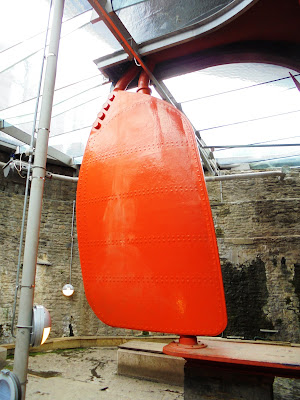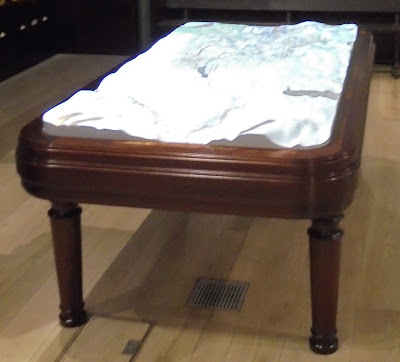At least once a year, Sue and I go to Bristol so that I can attend a Masonic meeting at the famous Bristol Masonic Centre in Park Street. (The Masonic ritual used in Bristol has many unique aspects, some of which may be due to the city's long connection with America.) We were supposed to pay a visit earlier in the year, but had to cancel at short notice when I came down with a case of Norovirus.
The hotel where we had booked and paid for a night's stay is located in the Clifton area of the city, and the management kindly offered us the opportunity to book a room at a reduced rate later in the year, and we decided to take them up on this offer. As we wanted to see a bit more of Bristol than we had on previous visits, we booked a two-night stay.
Tuesday 25th June
We left home at 11.30am, and drove around the M25 until we reached the interchange with the M4. We turned off onto the westbound carriageway, and by 2.30pm we had reached Leigh Delamere Services. We stopped there for a comfort break and a snack lunch, and despite a slight navigational glitch (the car's satnav tried to direct us towards the wrong Victoria Square!) we arrived at our hotel at 4.00pm.
The Victoria Square Hotel, Clifton.
Once we had unpacked and made ourselves comfortable, we had a rest until it was time to get ready for dinner. We had a pre-dinner drink in the hotel's bar before walking into the centre of Clifton Village, where we met up with an old friend and Bristolian for dinner. We ate in 'Fishers', a small fish restaurant in the Village, ...
Fishers Restaurant, Clifton.
... where the food was excellent and the service attentive without being intrusive. We did not leave until 10.00pm, and after saying our goodbyes, we walked back to our hotel.
The weather was very humid, and even with the window open, both of us felt uncomfortable. We tried reading for a while before going to sleep, but neither of us had a particularly good night's sleep.
Wednesday 26th June
We were both awake by 7.30am, and after taking our time to get ready, we went down to the hotel's restaurant for breakfast. Neither of us was very hungry, so we ate quite a small meal. Once that was over, we returned to our room to get ready for our day of sightseeing.
We left the hotel at 9.45am to drive the short distance to the location of the SS
Great Britain ... but Bristol's confusing traffic system, lack of adequate road signage, and numerous roadworks took its toll, and we didn't arrive at the venue's car park until well after 10.15am!
The cost of parking near the
Great Britain is interesting. It operates on a 'Pay and Display' system, and if you pay for two hours, it costs £2.00. If – on the other hand – you pay £5.00 for five hours parking, you are refunded £3.00 when you buy a ticket to enter the museum. It certainly discourages people from parking there and not visiting the museum!
The entrance to the SS Great Britain and its associated museum.
The cost of entry was £15.00 each (we both qualified for an age– related discount) and the entry ticket is valid for twelve months ... so we can go back again, and it won't cost us a penny more! The staff were extremely helpful and very knowledgeable, and nothing like many of the warding staff one finds in more traditional museums.
The stern of the SS Great Britain.
The bow and figurehead of the SS Great Britain.
The SS Great Britain's bow, as seen from above the waterline.
We began by going down into the dry dock so that we could see the hull of the ship. The space between the ship's side and the dock is glassed in, and is covered in a thin layer of running water. From below it gives you the impression you are walking underwater and – in my opinion – is better than the pure glass roof used around the
Cutty Sark in Greenwich.
The SS Great Britain's bow as seen from below the waterline.
Above and below: The replica of the ship's original propeller.
The replica of the SS Great Britain's balanced rudder.
We then went up to the above water part of the ship, passing through the very interesting museum that tells the story of the ship backwards from the time of her return to the UK until her building in Bristol in the very dock she now occupies.
The Dockside Museum. The SS Great Britain's original balanced rudder can be seen just behind the replica of the ship's second propeller to the left of the photograph. This propeller was designed to be lifted out of the water so that it did not interfere with the ship's movement when she was moving solely under sail power.
We started by walking around the upper deck, ...
The upper deck, looking aft.
The ship's bridge. It is a very simple raised platform that runs from side to side across the deck near the funnel.
The ship's main steering position. Thanks to the balanced rudder, it normally only needed one or two men to operate the ship's wheel.
The upper deck, looking forward.
... and the went below to the passenger accommodation. The interior of the ship has been recreated, and examples of the various types of cabin and public areas have been included. Other than the sumptuous First-class Dining Saloon (which doubled up as a meeting place and recreation area for the First-class passengers) most of the cabin spaces were very cramped, especially in the area occupied by the Steerage-class passengers.
The captain's cabin.
Above and below: Examples of the passenger cabins.
Another example of a passenger cabin. This one contained four berths, but did have washing facilities.
The Promenade Saloon. Some of the passenger cabins were located along each side of the saloon.
The First-class Dining Saloon. The tram-style seating was fixed to the floor but could be reversed so that the area could be used for entertainment as well as for eating.
The First-class passengers certainly seemed to have eaten well.
The ship's galley was surprisingly large (and badly lit!), ...
The galley's food preparation area.
Part of the galley's pantry and storage area.
... and the engine room was very impressive.
(The engine was designed by Thomas Guppy and Brunel, and had four 88-inch diameter cylinders arranged in a V-formation, with two on either side at an angle of 33 degrees to the vertical. It produced 1,000hp, and the cylinders drove a crankshaft with an 18' 3" diameter toothed chain wheel. Four chains, which weighed a total of seven tons, were used to transfer power from the chain wheel to the propeller shaft. The engine turned the crankshaft at 18 rpm, and the chain wheel and chains converted this by a ratio of 2.95:1 so that the propeller shaft turned at 53 rpm. This gave the ship a maximum speed of 12 knots when under steam power.)
Going back ashore, we had a quick drink in one of the museum's cafes before looking around the building dedicated to telling the life story of Isambard Kingdom Brunel.
It contained some very rare artefacts and a model of the SS
Great Britain ...
The Brunel family dining table.
Example of Brunel's plans and notebooks are on display.
Above and below: A model of the SS Great Britain as built.
... as well as some state-of-the-art displays, one of which tells the story of the building of the Great Western Railway using a projected animation onto a 3D map.
The animated map is projected onto a terrain model of the land between London and Bristol.
By 1.30pm Sue was beginning to suffer from information overload, and we made our way back to the car. we then drove to Cribb's Causeway, which is a large out-of-town retail park and shopping mall, where she was able to revitalise herself with some retail therapy. The latter included a very nice lunch in the cafeteria in the branch of John Lewis and Partners.
We were back at the hotel by just after 4.00pm, and Sue and I spent the next couple of hours relaxing in our room. (I slept for the best part of two hours whilst Sue read and dozed.) We then got ready to go out to dinner in a nearby pizzeria.
We had returned to our hotel by 10.00pm, and by 11.00pm we were both fast asleep.
Thursday 27th June
After sleeping better than we had expected, we were dressed, packed, and ready to eat breakfast in the hotel’s restaurant. Sue and I then settled our bill, loaded our luggage in the car, and were ready to set off for home by 9.00am.
I drove across the Clifton Suspension Bridge and then northwards towards the M5 in order to avoid having to drive through the centre of Bristol. The eastbound M5 was not too crowded, and by 9.30am we had joined the London-bound carriageway of the M4 and were on our way towards Swindon.
By 11.00am we had reached Reading Services, where we stopped for a comfort break and to buy some food in the onsite branch of Marks and Spencer Simply Food.
Rather than travel all the way into London on the M4, we turned off onto the southern loop of the M25. The traffic was heavy in places, but there were no major holdups and we arrived home a few minutes before 1.00pm.























































.jpg)






























